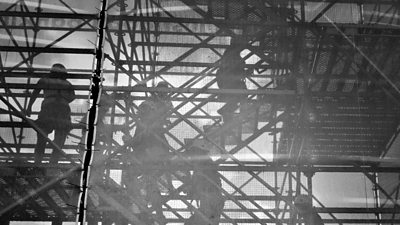This Guide assists those planning, conducting or managing others who work at height. It is a general introduction to the control measures likely to be required, including on flat roofs – more detailed information on specific means of access can be found in our other Work at Height Safety Guides
A place is 'at height' if you could be injured falling from it, even if it is at or below ground level. Examples of workplaces ‘at height’ include rostra, stages, ladders, scaffold platforms, roofs, gantries, cherry pickers, but also many locations in the natural environment such as up trees, down caves or on cliff faces. Many people will, at times, be asked to work at height, either as part of their normal job, or to carry out specific one-off tasks.
What Can Go Wrong?
- Falls from height - including off steps, stages, rostra and other access equipment, or through fragile roofing, or down pits and excavations
- Struck by falling objects - you could be struck by these or drop them onto people below
- Vertigo / fear of heights – can traumatise those affected
- Stuck at height – inadequate rescue capabilities.
Legal/�������� Requirements
- Ensure work at height is properly planned and organised
- Ensure those involved in work at height are competent and willing to do so - �������� policy states that individuals are free to choose not to work at height
- Ensure risks from work at height are assessed, and appropriate work equipment is selected and used
- Ensure equipment used for work at height is properly inspected and maintained
- The risks of working on or near fragile surfaces are properly managed.
Control Measures
Planning work at height
- If you can, avoid work at height - this could simply be to keep everyone well back from any unprotected drops. Inevitably, there will be times on location when people will momentarily pass close to unprotected drops (e.g. flat roof edge, cliff path, quayside, pit or open tank, etc.), but such access should be prevented when the risk of slips, trips and falls are significant, for example, when carrying heavy items, concentrating on other work tasks, in poor weather, lack of daylight, poor ground conditions, etc.
- if you can't avoid working at height, make sure measures are in place to prevent anyone falling. Edge protection, which protects everyone all of the time, is preferable to personal protection measures i.e. harness and lanyard, which may not be used correctly or perhaps not used at all. Where edge protection is provided, confirm that it protects all areas where you will be working, is secure, around 1m in height and with no gaps in it more than 470mm wide (see also our Scaffolding Guideline in Related Topics)
- If edge protection isn't provided, personal protective equipment will be required (e.g. harnesses, ropes, lanyards, anchor points, connectors, etc. - see Rope Access Techniques in Related Topics). When working on a flat roof / platform with easy access, see our guidance below
- Where more specialised access methods and protection are required, see our other work at height Guidelines (see Related Topics). Some specialist access methods (e.g. scaffolding, flying ballet, mobile elevating work platforms) must be provided by a �������� pre-vetted contractor (see Working with Contractors in Related Topics)
- All work at height should be covered by risk assessment, whether provided by production or by an engaged expert / contractor.
Work on structures and flat roofs
- Check with building owners / managers on the safe means of access to their roof – what safety measures are in place and how to comply with them, and are they competent to supervise your access? Do you need to climb any fixed vertical ladders? If so, can this be done safely, and when carrying equipment? Which route to your location avoids stepping on fragile surfaces / equipment? Is there a permit to work system to control access?
- Access to roof level working area – is there a safe permanent access route e.g. enclosed staircase or marked walkway? If a temporary access method is required, for example, via a portable ladder, can this be secured in place to prevent movement and extend beyond the roof level to provide suitable handholds for accessing and leaving it?
- Can the roof safely support the load placed on it by your team and equipment? If there are concerns, you may have to engage a structural engineer to determine its load bearing capabilities
- Avoid fragile surfaces such as glazing panels or lightweight roofing materials – if necessary, either place warning signs (if not already present), or better still, cordon them off to prevent inadvertent access. Note: the absence of any warning signs does not mean the roof is safe to access
- On flat roofs, check for presence and condition of edge protection – if not present, check if you can access the areas you need without being close to an exposed drop (for example, within 2-3m). If this isn’t practical, investigate possibility of installing temporary edge protection or engaging a competent person to provide work restraint equipment / techniques
- Check that items can’t fall onto persons below, either by being accidentally kicked off, dropped or blown off by the wind. Where suitable edge protection is not in place (including kickboards or a parapet), secure all loose items to prevent movement, for example, by attaching to belts or lanyards, placing in heavy bags, doing up pockets or using ties. All flown cables / lights / mics must be securely tied / clamped, and as necessary safety bonded, to a solid structure.
- Exclusion zone – if it isn’t practical to prevent items from being accidentally dropped or knocked from a roof or working platform, then you must establish a suitably sized exclusion zone beneath those working at height. Any team members who need to enter this area can only do so by first notifying others of their presence and they must also wear suitable head protection (e.g. builders hard hat or climbing helmet)
- Any access requiring use of fall arrest techniques to minimise the distance or consequences of a potential fall (e.g. fall arrest harness / lanyard, nets, airbags) can only be used by trained and competent people using a well-defined safe system of work. This type of equipment requires a separate risk assessment and is not covered by this guide.
Division Specific Issues
- Incorporating Radio OB MS M014-09 Working at Heights.
FAQs/Did You Know?
- Approx. one third of all reportable 'fall from height' accidents in the workplace involve portable ladders, accounting for approx.14 deaths and 1200 major injuries each year.
Useful documents
Recommended links
Working at Height topics
 GeneralGuidance to assist planning, conducting or managing staff who are working at height
GeneralGuidance to assist planning, conducting or managing staff who are working at height Gantries & High Level PlatformsGuidance on media positions within stadiums and arenas
Gantries & High Level PlatformsGuidance on media positions within stadiums and arenas LaddersGuidance on ladders to work up to approx. 6m high
LaddersGuidance on ladders to work up to approx. 6m high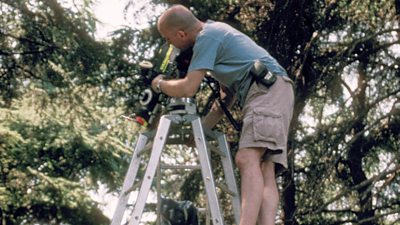 Ladder PodsGuidance on ladder pods to work up to 5m high
Ladder PodsGuidance on ladder pods to work up to 5m high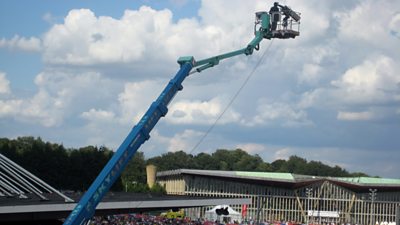 Mobile Elevating Work PlatformsGuidance on mobile elevating work platforms (MEWP) such as cherry pickers and scissor lifts.
Mobile Elevating Work PlatformsGuidance on mobile elevating work platforms (MEWP) such as cherry pickers and scissor lifts.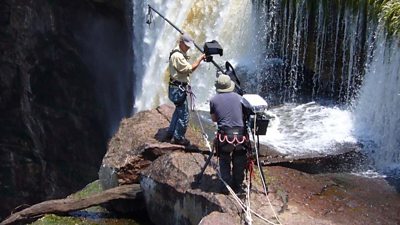 Rope Access TechniquesThe equipment and techniques required to protect those working at or near exposed drops.
Rope Access TechniquesThe equipment and techniques required to protect those working at or near exposed drops.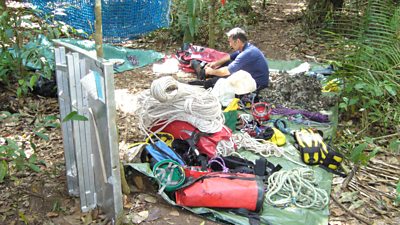 Ropes Riggers: Selection of Competence criteria for the various professional Ropes Riggers.
Ropes Riggers: Selection of Competence criteria for the various professional Ropes Riggers.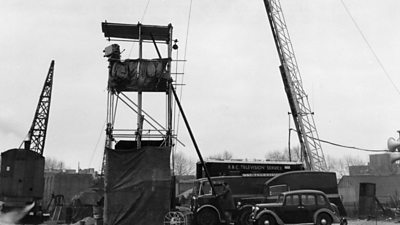 Tower ScaffoldsGuidance on tower scaffolds to work up to approx 8m high
Tower ScaffoldsGuidance on tower scaffolds to work up to approx 8m high
More from SSR
- Your platform to record accidents, risk assessments, assurance monitoring and inspections
- Safety Equipment StoresJust one number to call: 0844 800 8875
- �������� Safety GuidelinesAn A-Z of ��������'s Health and Safety Guidelines
- Safety Advice Line: 0370 411 0464 Email: safety@bbc.co.uk
- A-Z of �������� Safety Guidelines
- Accident Reporting and Investigation
- �������� Health & Safety Policy
- Contractors (incl. vetted lists)
- Contributors
- Fire Safety
- Freelancers
- Independent Production Companies
- Risk Assessment
- Safety Alerts
- Safety Responsibilities
- Safety Training
- Sets & Premises Safety Guide
Events guidance - key links:
- Exhibitions
- General Guidance
- Indoor Location Recce Checklist
- Outdoor Location Recce Checklist
- Major Incidents & Emergency Planning
- Marketing and Promotional
- Noise Exposure
- Planning and Management
- Responsibilities
- Responsibilities Form
- Laser Lighting Effects
- Strobe Lighting
- Temporary Stages and Rostra
Health topics - key links:
- (�������� network only)
- Contributors Fitness to Participate
- Display Screen Equipment (DSE)
- (�������� network only)
- First Aid and Welfare on Location
- International Travel - Risks & Health
- Manual Handling
- Mental Health: ��������page
- (�������� network only)
- Personal Health and Wellbeing
- Pregnancy
- Psychological Trauma Support & Trauma Risk Management (TRiM)
- Tiredness and Fatigue
- Travel Health Contacts
�������� High Risk - key links:
- CBRN and Industrial Spills
- Covert Filming
- Crisis Management and Security Support
- Demonstrations, Protests and Crowds
- Disaster Coverage
- Door Stepping
- (�������� network only)
- (�������� network only)
- Public Order
- Safety Equipment Stores
�������� Journalism - key links:
�������� Productions - key links:
- Aerial Filming and Airfields
- Animals: Displaying and handling for performance
- Boats: Working on
- Children and Young People
- Driving
- Electrical Equipment and Systems
- First Aid and Welfare on Location
- Food Safety (Cooking and Catering)
- Remote Location Working
- Roads and Streets: Working by
- Security of Productions on Location
- Stunts
- Tiredness and Fatigue
- Unmanned Aerial Systems (UAS aka Drones)
- Vehicles: Recording in, from and around
- Working at Height: Mobile Elevating Work Platforms
- Working at Height: Tower Scaffolds
- (�������� Network only)
�������� Security - key links:
�������� Sport - key links:
About this site
This site describes what the �������� does in relation to managing its health, safety and security risks and is intended for those who work directly for the ��������.
It is not intended to provide instruction or guidance on how third parties should manage their risks. The �������� cannot be held liable for how this information is interpreted or used by third parties, nor provide any assurance that adopting it would provide any measure of legal compliance. More information
Some links on this site are only accessible when connected to the �������� network

